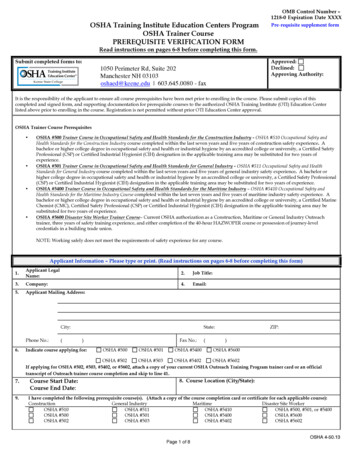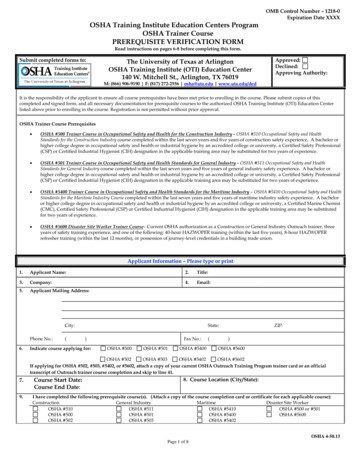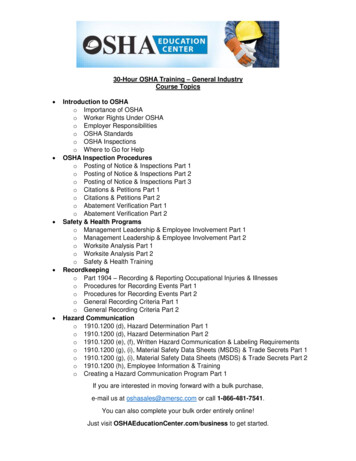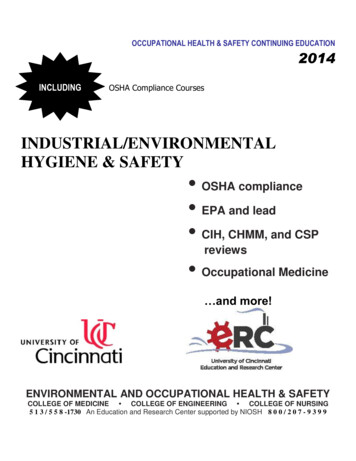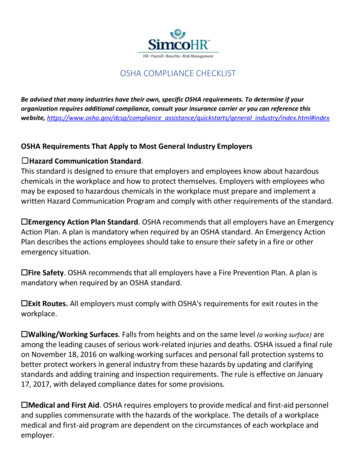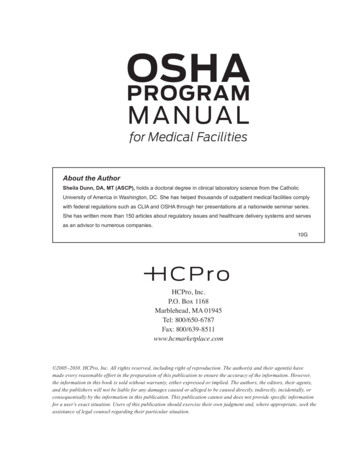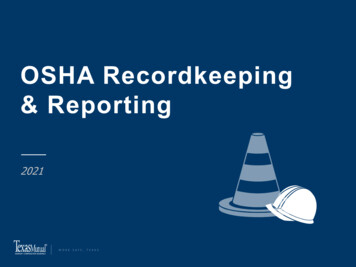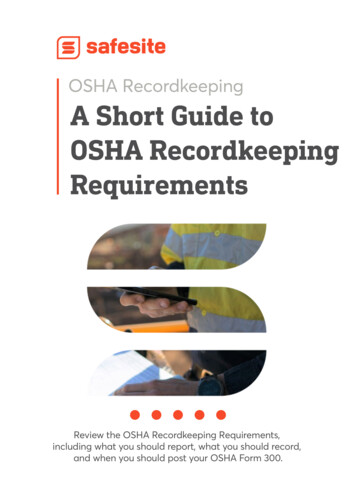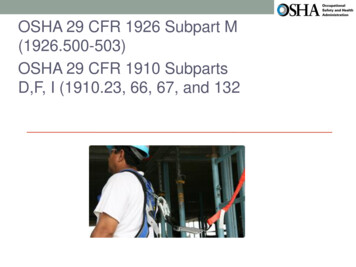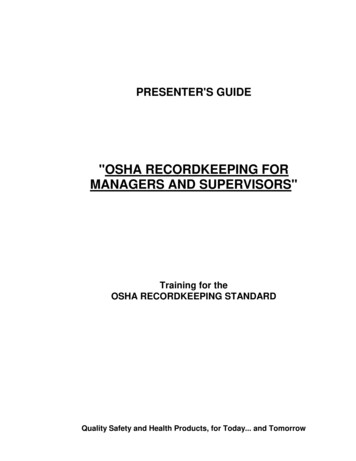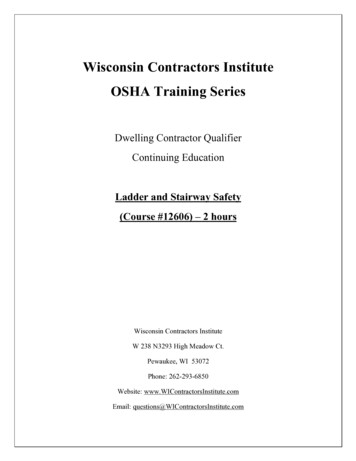
Transcription
Wisconsin Contractors InstituteOSHA Training SeriesDwelling Contractor QualifierContinuing EducationLadder and Stairway Safety(Course #12606) – 2 hoursWisconsin Contractors InstituteW 238 N3293 High Meadow Ct.Pewaukee, WI 53072Phone: 262-293-6850Website: www.WIContractorsInstitute.comEmail: questions@WIContractorsInstitute.com
Ladder and Stairway SafetyIntroduction.2General Requirements.2Rules for Ladders.3All Ladders.3Specific Types of Ladders.6Stepladders .6Portable Ladders.6Fixed Ladders.7Cages for Fixed Ladders.9Wells for Fixed Ladders.10Ladder Safety Devices and Related Support Systems for Fixed Ladders.11Requirements for Mounting Ladder Safety Devices for Fixed Ladders.12Defective Ladders.12Rules for Stairways.13Stairways Used During Construction.13Temporary Stairs.14Stair Rails.14Handrails.15Midrails.15Training Requirements.17Glossary.171
IntroductionWorking on and around stairways and ladders is hazardous. Stairways and ladders are majorsources of injuries and fatalities among construction workers for example, and many of theinjuries are serious enough to require time off the job. OSHA estimates that there are almost25,000 injuries and as many as 36 fatalities per year due to falls on stairways and ladders used inconstruction.OSHA rules apply to all stairways and ladders used in construction, alteration, repair, painting,decorating and demolition of worksites covered by OSHA’s construction safety and healthstandards.This course is based on OSHA’s 29 CFR 1926.1050-1060 (Subpart X).1.) OSHA rules on ladders can be found in which subpart of CFR 1926?a. Ub. Vc. Wd. X2.) According to OSHA estimates, how many injuries occur per year on ladders andstairways?a. 25b. 250c. 2,500d. 25,000General RequirementsThese rules specify when employers must provide stairways and ladders. In general, thestandards require the following: When there is a break in elevation of 19 inches (48 cm) or more and no ramp, runway,embankment or personnel hoist is available, employers must provide a stairway or ladderat all worker points of access.2
When there is only one point of access between levels, employers must keep it clear ofobstacles to permit free passage by workers. If free passage becomes restricted,employers must provide a second point of access and ensure that workers use it. When there are more than two points of access between levels, employers must ensurethat at least one point of access remains clear.In addition, employers must install all stairway and ladder fall protection systems required bythese rules and ensure that their worksite meets all requirements of the stairway and ladder rulesbefore employees use stairways or ladders.Note: The standard does not apply to ladders specifically manufactured for scaffold access andegress, but does apply to job-made and manufactured portable ladders intended for generalpurpose use. Rules for ladders used on or with scaffolds are addressed in 29 CFR 1926.451Subpart L.3.) When there is a break in elevation of inches or more, and no ramp, runway, orpersonnel hoist is available, employers must provide a stairway or ladder.a. 12 inchesb. 19 inchesc. 24 inchesd. 36 inchesRules for LaddersAll LaddersThe following rules apply to all ladders: Maintain ladders free of oil, grease and other slipping hazards. Do not load ladders beyond their maximum intended load nor beyond theirmanufacturer’s rated capacity. Use ladders only for their designed purpose.3
Use ladders only on stable and level surfaces unless secured to prevent accidentalmovement. Do not use ladders on slippery surfaces unless secured or provided with slip-resistant feetto prevent accidental movement. Do not use slip resistant feet as a substitute for exercising care when placing, lashing orholding a ladder upon slippery surfaces. Secure ladders placed in areas such as passageways, doorways or driveways, or wherethey can be displaced by workplace activities or traffic to prevent accidental movement.Or use a barricade to keep traffic or activity away from the ladder. Keep areas clear around the top and bottom of ladders. Do not move, shift or extend ladders while in use. Use ladders equipped with nonconductive side rails if the worker or the ladder couldcontact exposed energized electrical equipment. Face the ladder when moving up or down. Use at least one hand to grasp the ladder when climbing. Do not carry objects or loads that could cause loss of balance and falling.In addition, the following general requirements apply to all ladders, including ladders built at thejobsite: Double-cleated ladders or two or more ladders must be provided when ladders are theonly way to enter or exit a work area where 25 or more employees work or when a ladderserves simultaneous two-way traffic. Ladder rungs, cleats and steps must be parallel, level and uniformly spaced when theladder is in position for use. Rungs, cleats and steps of portable and fixed ladders (except as provided below) must notbe spaced less than 10 inches (25 cm) apart, nor more than 14 inches (36 cm) apart, alongthe ladder’s side rails.4
Rungs, cleats and steps of step stools must not be less than 8 inches (20 cm) apart, normore than 12 inches (31 cm) apart, between center lines of the rungs, cleats and steps. Rungs, cleats and steps at the base section of extension trestle ladders must not be lessthan 8 inches (20 cm) nor more than 18 inches (46 cm) apart, between center lines of therungs, cleats and steps. The rung spacing on the extension section must not be less than 6inches (15 cm) nor more than 12 inches (31 cm). Ladders must not be tied or fastened together to create longer sections unless they arespecifically designed for such use. When splicing side rails, the resulting side rail must be equivalent in strength to a onepiece side rail made of the same material. Two or more separate ladders used to reach an elevated work area must be offset with aplatform or landing between the ladders, except when portable ladders are used to gainaccess to fixed ladders. Ladder components must be surfaced to prevent snagging of clothing and injury frompunctures or lacerations. Wood ladders must not be coated with any opaque covering except for identification orwarning labels, which may be placed only on one face of a side rail.Note: A competent person must inspect ladders for visible defects periodically and after anyincident that could affect their safe use.4.) The following rules apply to all laddersa. Maintain ladders free of oil and other slipping hazardsb. Do not load ladders beyond their maximum intended loadc. Use ladders for only their designed purposed. All of the above5.) Which one of the statements below is NOT true about rules that apply to laddersa. It is best to extend the ladder while in useb. Keep areas clear around the top and bottom of laddersc. Face the ladder when moving up or downd. Use at least one hand to grasp the ladder when climbing5
6.) Ladder components must be surfaced to prevent snagging of clothing and injuryfrom punctures or lacerations. This statement is:a. Trueb. False7.) Wood ladders must be coated entirely with an opaque covering :a. Trueb. FalseSpecific Types of Ladders Do not use single-rail ladders. Use non-self-supporting ladders at an angle where the horizontal distance from the topsupport to the foot of the ladder is approximately one-quarter of the working length of theladder. Use wooden ladders built at the jobsite with spliced side rails at an angle where thehorizontal distance is one-eighth of the working length of the ladder.In addition, the top of a non-self-supporting ladder must be placed with two rails supportedequally unless it is equipped with a single support attachment.Stepladders Do not use the top or top step of a stepladder as a step. Do not use cross bracing on the rear section of stepladders for climbing unless the laddersare designed and provided with steps for climbing on both front and rear sections. Metal spreader or locking devices must be provided on stepladders to hold the front andback sections in an open position when ladders are being used.Portable LaddersThe minimum clear distance between side rails for all portable ladders must be 11.5 inches (29cm).6
In addition, the rungs and steps of portable metal ladders must be corrugated, knurled, dimpled,coated with skid-resistant material or treated to minimize slipping.Non-self-supporting and self-supporting portable ladders must support at least four times themaximum intended load; extra heavy-duty type 1A metal or plastic ladders must sustain 3.3times the maximum intended load. To determine whether a self-supporting ladder can sustain acertain load, apply the load to the ladder in a downward vertical direction with the ladder placedat a horizontal angle of 75.5 degrees.When portable ladders are used for access to an upper landing surface, the side rails must extendat least 3 feet (.9 m) above the upper landing surface. When such an extension is not possible, theladder must be secured and a grasping device such as a grab rail must be provided to assistworkers in mounting and dismounting the ladder. A ladder extension must not deflect under aload that would cause the ladder to slip off its supports.8.) What is the minimum clear distance between side rails for all portable ladders?a. 9 inchesb. 10.5 inchesc. 11.5 inchesd. 13 inches9.) When portable ladders are used for access to an upper landing surface, the side railsmust extend:a. 1 foot about the upper landing surfaceb. 2 feet above the upper landing surfacec. 3 feet above the upper landing surfaced. 4 feet above the upper landing surfaceFixed Ladders If the total length of the climb on a fixed ladder equals or exceeds 24 feet (7.3 m), theladder must be equipped with ladder safety devices; or self-retracting lifelines and restplatforms at intervals not to exceed 150 feet (45.7 m); or a cage or well and multipleladder sections with each ladder section not to exceed 50 feet (15.2 m) in length. Theseladder sections must be offset from adjacent sections and landing platforms must beprovided at maximum intervals of 50 feet (15.2 m). In addition, fixed ladders must meetthe following requirements:7
Fixed ladders must be able to support at least two loads of 250 pounds (114 kg) each,concentrated between any two consecutive attachments. Fixed ladders also must supportadded anticipated loads caused by ice buildup, winds, rigging and impact loads resultingfrom using ladder safety devices. Individual rung/step ladders must extend at least 42 inches (1.1 m) above an access levelor landing platform either by the continuation of the rung spacings as horizontal grab barsor by providing vertical grab bars that must have the same lateral spacing as the verticallegs of the ladder rails. Each step or rung of a fixed ladder must be able to support a load of at least 250 pounds(114 kg) applied in the middle of the step or rung. Minimum clear distance between the sides of individual rung/step ladders and betweenthe side rails of other fixed ladders must be 16 inches (41 cm). Rungs of individual rung/step ladders must be shaped to prevent slipping off the end ofthe rungs. Rungs and steps of fixed metal ladders manufactured after March 15, 1991, must becorrugated, knurled, dimpled, coated with skid-resistant material or treated to minimizeslipping. Minimum perpendicular clearance between fixed ladder rungs, cleats, and steps and anyobstruction behind the ladder must be 7 inches (18 cm), except that the clearance for anelevator pit ladder must be 4.5 inches (11 cm). Minimum perpendicular clearance between the centerline of fixed ladder rungs, cleatsand steps, and any obstruction on the climbing side of the ladder must be 30 inches (76cm). If obstructions are unavoidable, clearance may be reduced to 24 inches (61 cm),provided a deflection device is installed to guide workers around the obstruction. Step-across distance between the center of the steps or rungs of fixed ladders and thenearest edge of a landing area must be no less than 7 inches (18 cm) and no more than 12inches (30 cm). A landing platform must be provided if the step-across distance exceeds12 inches (30 cm). Fixed ladders without cages or wells must have at least a 15-inch (38 cm) clearance widthto the nearest permanent object on each side of the centerline of the ladder.8
Fixed ladders must be provided with cages, wells, ladder safety devices or self-retractinglifelines where the length of climb is less than 24 feet (7.3 m) but the top of the ladder isat a distance greater than 24 feet (7.3 m) above lower levels. Side rails of through or side-step fixed ladders must extend 42 inches (1.1 m) above thetop level or landing platform served by the ladder. Parapet ladders must have an accesslevel at the roof if the parapet is cut to permit passage through it. If the parapet iscontinuous, the access level is the top of the parapet. Steps or rungs for through-fixed-ladder extensions must be omitted from the extension;and the extension of side rails must be flared to provide between 24 inches (61 cm) and30 inches (76 cm) clearance between side rails. When safety devices are provided, the maximum clearance distance between side railextensions must not exceed 36 inches (91 cm). Fixed ladders must be used at a pitch no greater than 90 degrees from the horizontal,measured from the back side of the ladder.10.)Minimum clear distance between the sides of individual rung/step laddersand between the side rails of other fixed ladders must be inches.a. 16 inchesb. 20 inchesc. 24 inchesd. 29 inches11.)Fixed ladders without cages or wells must have at least a 20-inch clearancewidth to the nearest permanent object on each side of the centerline of the ladder.a. Trueb. FalseCages for Fixed LaddersThe requirements for cages for fixed ladders are as follows:9
Horizontal bands must be fastened to the side rails of rail ladders or directly to thestructure, building or equipment for individual-rung ladders. Vertical bars must be on the inside of the horizontal bands and must be fastened to them. Cages must not extend less than 27 inches (68 cm), or more than 30 inches (76 cm) fromthe centerline of the step or rung and must not be less than 27 inches (68 cm) wide. Insides of cages must be clear of projections. Horizontal bands must be spaced at intervals not more than 4 feet (1.2 m) apart measuredfrom centerline to centerline. Vertical bars must be spaced at intervals not more than 9.5 inches (24 cm), measuredcenterline to centerline. Bottoms of cages must be between 7 feet (2.1 m) and 8 feet (2.4 m) above the point ofaccess to the bottom of the ladder. The bottom of the cage must be flared not less than 4inches (10 cm) between the bottom horizontal band and the next higher band. Tops of cages must be a minimum of 42 inches (1.1 m) above the top of the platform orthe point of access at the top of the ladder. There must be a way to access the platform orother point of access.Wells for Fixed LaddersThe requirements for wells for fixed ladders are as follows: Wells must completely encircle the ladder. Wells must be free of projections. Inside faces of wells on the climbing side of the ladder must extend between 27 inches(68 cm) and 30 inches (76 cm) from the centerline of the step or rung. Inside widths of wells must be at least 30 inches (76 cm). Bottoms of wells above the point of access to the bottom of the ladder must be between 7feet (2.1 m) and 8 feet (2.4 m).10
12.)d.The requirements for wells for fixed ladders are as follows:Wells must completely encircle the ladderWells must be free of projectionsBottoms of wells above the points of access to the bottom of the ladder must bebetween 7 feet and 8 feetAll of the abovea.b.c.d.The inside widths of wells for fixed ladders must be at least:20 inches30 inches40 inches50 inchesa.b.c.13.)Ladder Safety Devices and Related Support Systems for Fixed LaddersThe connection between the carrier or lifeline and the point of attachment to the body belt orharness must not exceed 9 inches (23 cm) in length. In addition, ladder safety devices and relatedsupport systems on fixed ladders must conform to the following: All safety devices must be able to withstand, without failure, a drop test consisting of a500-pound weight (226 kg) dropping 18 inches (41 cm). All safety devices must permit the worker to ascend or descend without continuallyhaving to hold, push or pull any part of the device, leaving both hands free for climbing. All safety devices must be activated within 2 feet (.61 m) after a fall occurs and limit thedescending velocity of an employee to 7 feet/second (2.1 m/sec) or less.Requirements for Mounting Ladder Safety Devices for Fixed LaddersThe requirements for mounting ladder safety devices for fixed ladders are as follows:11
Mountings for rigid carriers must be attached at each end of the carrier, with intermediatemountings spaced along the entire length of the carrier, to provide the necessary strengthto stop workers’ falls. Mountings for flexible carriers must be attached at each end of the carrier. Cable guidesfor flexible carriers must be installed with a spacing between 25 feet (7.6 m) and 40 feet(12.2 m) along the entire length of the carrier, to prevent wind damage to the system. Design and installation of mountings and cable guides must not reduce the strength of theladder. Side rails and steps or rungs for side-step fixed ladders must be continuous in extension.Defective LaddersLadders needing repairs are subject to the following rules: Portable ladders with structural defects—such as broken or missing rungs, cleats or steps,broken or split rails, corroded components or other faulty or defective components—mustimmediately be marked defective or tagged with "Do Not Use" or similar language andwithdrawn from service until repaired. Fixed ladders with structural defects—such as broken or missing rungs, cleats or steps,broken or split rails or corroded components—must be withdrawn from service untilrepaired. Defective fixed ladders are considered withdrawn from use when they are immediatelytagged with "Do Not Use" or similar language, or marked in a manner that identifiesthem as defective, or blocked—such as with a plywood attachment that spans severalrungs. Ladder repairs must restore the ladder to a condition meeting its original design criteriabefore the ladder is returned to use.14.)Side rails and steps or rungs for side-step fixed ladders must be continuous inextensiona. Trueb. False12
15.)a.b.c.d.Ladder needing repair are subject to the following rule(s):Portable ladders with structural defects must be marked with “Don Not Use”Fixed ladders with structural defects must be withdrawn from service untilrepairedLadder repairs must restore the ladder to a condition meeting its original designcriteriaAll of the aboveRules for StairwaysThe rules covering stairways and their components generally depend on how and when stairs areused. Specifically, there are rules for stairs used during construction and stairs used temporarilyduring construction, as well as rules governing stair rails and handrails.Stairways Used During ConstructionThe following requirements apply to all stairways used during construction: Stairways that will not be a permanent part of the building under construction must havelandings at least 30 inches deep and 22 inches wide (76 x 56 cm) at every 12 feet (3.7 m)or less of vertical rise. Stairways must be installed at least 30 degrees—and no more than 50 degrees—from thehorizontal. Variations in riser height or stair tread depth must not exceed 1/4 inch in any stairwaysystem, including any foundation structure used as one or more treads of the stairs. Doors and gates opening directly onto a stairway must have a platform that extends atleast 20 inches (51 cm) beyond the swing of the door or gate. Metal pan landings and metal pan treads must be secured in place before filling. Stairway parts must be free of dangerous projections such as protruding nails. Slippery conditions on stairways must be corrected. Workers must not use spiral stairways that will not be a permanent part of the structure.13
Temporary StairsThe following requirements apply to stairways used temporarily during construction.Except during construction of the stairway, Do not use stairways with metal pan landings and treads if the treads and/or landingshave not been filled in with concrete or other materials unless the pans of the stairs and/orlandings are temporarily filled in with wood or other materials. All treads and landingsmust be replaced when worn below the top edge of the pan. Do not use skeleton metal frame structures and steps (where treads and/or landings willbe installed later) unless the stairs are fitted with secured temporary treads and landings.Note: Temporary treads must be made of wood or other solid material and installed the full widthand depth of the stair.Stair RailsThe following general requirements apply to all stair rails: Stairways with four or more risers or rising more than 30 inches (76 cm) in height—whichever is less—must be installed along each unprotected side or edge. When the topedge of a stair rail system also serves as a handrail, the height of the top edge must be nomore than 37 inches (94 cm) nor less than 36 inches (91.5 cm) from the upper surface ofthe stair rail to the surface of the tread. Stair rails installed after March 15, 1991, must be not less than 36 inches (91.5 cm) inheight. Top edges of stair rail systems used as handrails must not be more than 37 inches (94 cm)high nor less than 36 inches (91.5 cm) from the upper surface of the stair rail system tothe surface of the tread. (If installed before March 15, 1991, not less than 30 inches). Stair rail systems and handrails must be surfaced to prevent injuries such as punctures orlacerations and to keep clothing from snagging. Ends of stair rail systems and handrails must be built to prevent dangerous projections,such as rails protruding beyond the end posts of the system.In addition,14
Unprotected sides and edges of stairway landings must have standard 42-inch (1.1 m)guardrail systems. Intermediate vertical members, such as balusters used as guardrails, must not be morethan 19 inches (48 cm) apart. Other intermediate structural members, when used, must be installed so that no openingsare more than 19 inches (48 cm) wide. Screens or mesh, when used, must extend from the top rail to the stairway step and alongthe opening between top rail supports.HandrailsRequirements for handrails are as follows: Handrails and top rails of the stair rail systems must be able to withstand, without failure,at least 200 pounds (890 n) of weight applied within 2 inches (5 cm) of the top edge inany downward or outward direction, at any point along the top edge. Handrails must not be more than 37 inches (94 cm) high nor less than 30 inches (76 cm)from the upper surface of the handrail to the surface of the tread. Handrails must provide an adequate handhold for employees to grasp to prevent falls. Temporary handrails must have a minimum clearance of 3 inches (8 cm) between thehandrail and walls, stair rail systems and other objects. Stairways with four or more risers, or that rise more than 30 inches (76 cm) in height—whichever is less—must have at least one handrail. Winding or spiral stairways must have a handrail to prevent use of areas where the treadwidth is less than 6 inches (15 cm).MidrailsMidrails, screens, mesh, intermediate vertical members or equivalent intermediate structuralmembers must be provided between the top rail and stairway steps to the stair rail system. Whenmidrails are used, they must be located midway between the top of the stair rail system and thestairway steps.15
16.)Stairways that will not be a permanent part of the building underconstruction must have landings at least 30 inches deep and 22 inches wide at every12 feet or less of vertical rise:a. Trueb. False17.)Workers must not use a spiral stairway that will not be a permanent part ofthe structure.a. Trueb. False18.)a.b.c.d.Stair rails installed after March 15, 1991, must not be less than:36 inches in height40 inches in height44 inches in height48 inches in height19.)The minimum clearance for temporary handrails between the handrail andthe walls, stair rail systems and other objects must be:a. 2 inchesb. 3 inchesc. 4 inchesd. 6 inches20.)Unprotected sides and edges of stairway landings must have standardguardrail systems.a. 32-inchb. 36-inchc. 42-inchd. 46-inch21.)Winding or spiral stairways must have a handrail to prevent use of areaswhere the tread is less than:a. 3 inchesb. 4 inchesc. 5 inchesd. 6 inches16
22.)a.b.c.d.Except during the construction of the stairway:Do not use stairways with metal pan landings and treads if they haven’t beenfilled inAll treads and landing must be replaced when worn below the top edge of the panDo not use skeleton metal frame structures and stepsAll of the aboveTraining RequirementsEmployers must train all employees to recognize hazards related to ladders and stairways, andinstruct them to minimize these hazards. For example, employers must ensure that eachemployee is trained by a competent person in the following areas, as applicable: Nature of fall hazards in the work area; Correct procedures for erecting, maintaining and disassembling the fall protectionsystems to be used; Proper construction, use, placement and care in handling of all stairways and ladders; and Maximum intended load-carrying capacities of ladders used.Note: Employers must retrain each employee as necessary to maintain their understanding andknowledge on the safe use and construction of ladders and stairs.Glossarycleat —A ladder crosspiece of rectangular cross section placed on edge upon which a personmay step while ascending or descending a ladder.double-cleat ladder —A ladder with a center rail to allow simultaneous two-way traffic foremployees ascending or descending.failure — Load refusal, breakage or separation of components.fixed ladder — A ladder that cannot be readily moved or carried because it is an integral part ofa building or structure.handrail — A rail used to provide employees with a handhold for support.17
job-made ladder — A ladder that is fabricated by employees, typically at the construction site;non-commercially manufactured. load refusal — The point where the structural members losetheir ability to carry the load.point of access — All areas used by employees for work-related passage from one area or levelto another.portable ladder — A ladder that can be readily moved or carried.riser height — The vertical distance from the top of a tread or platform/landing to the top of thenext higher tread or platform/landing.side-step fixed ladder — A fixed ladder that requires a person to get off at the top to step to theside of the ladder side rails to reach the landing.single-cleat ladder — A ladder consisting of a pair of side rails connected together by cleats,rungs or steps.stair rail system — A vertical barrier erected along the unprotected sides and edges of astairway to prevent employees from falling to lower levels.temporary service stairway — A stairway where permanent treads and/or landings are to befilled in at a later date.through fixed ladder — A fixed ladder that requires a person getting off at the top to stepbetween the side rails of the ladder to reach the landing.tread depth — The horizontal distance from front to back of a tread, excluding nosing, if any.18
In addition, the rungs and steps of portable metal ladders must be corrugated, knurled, dimpled, coated with skid-resistant material or treated to minimize slipping. Non-self-supporting and self-supporting portable ladders must support at least four times the maximum intended load; extra heavy-duty type 1A metal or plastic ladders must sustain 3.3
